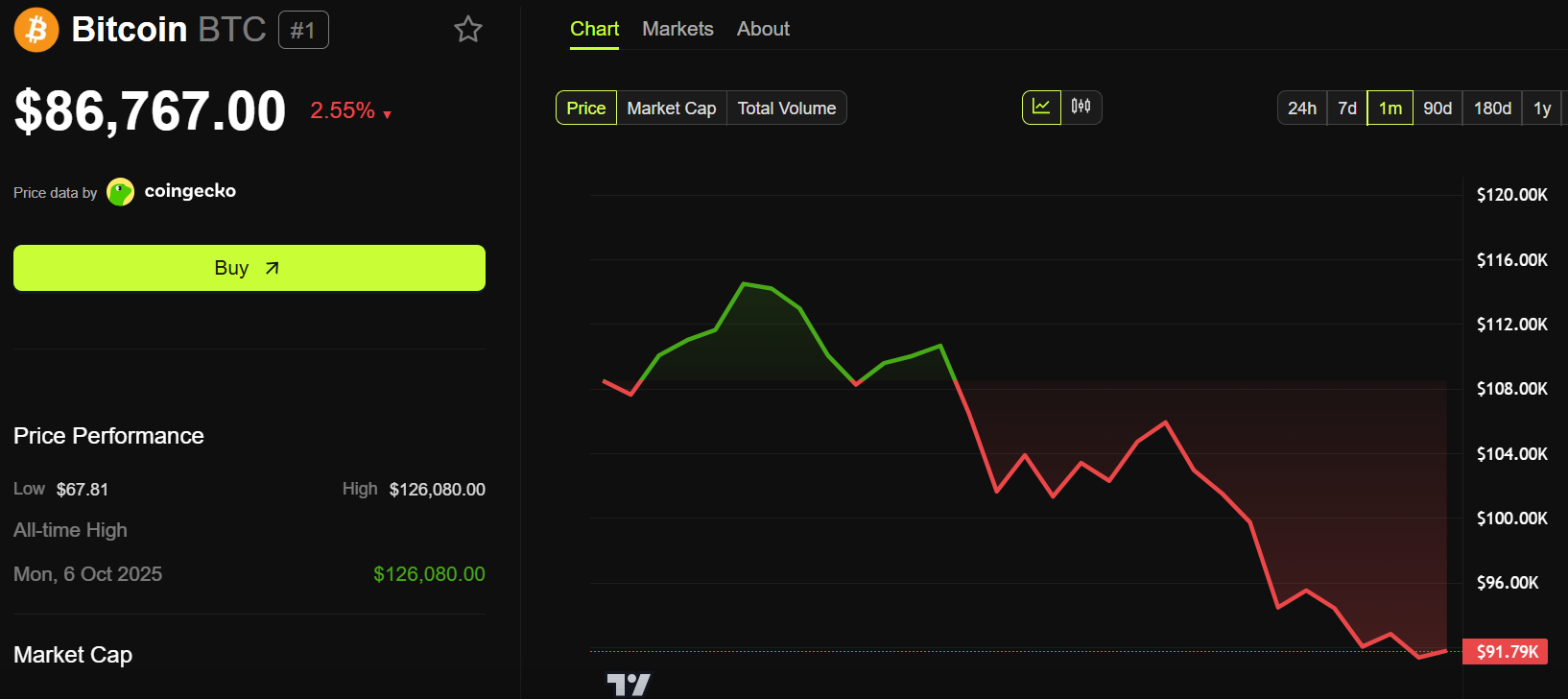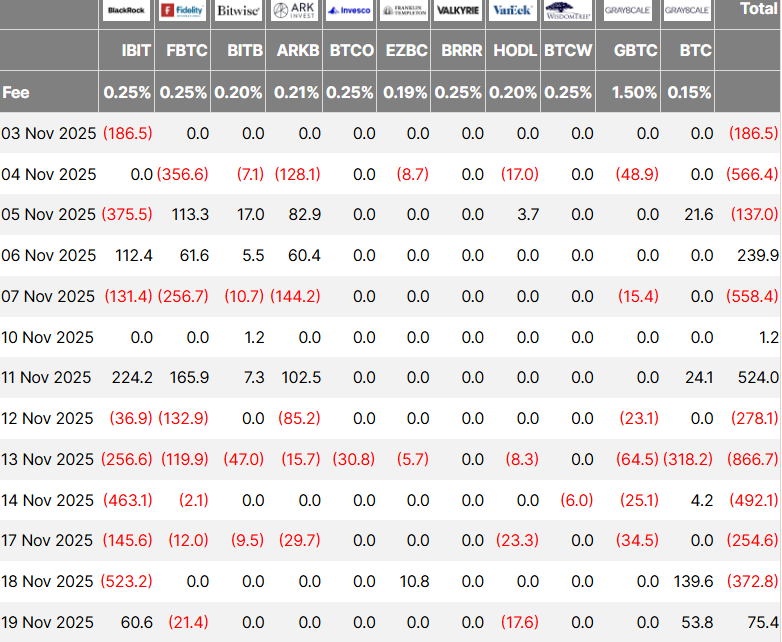Whale Dump Meets Quantum Panic: Bitcoin Slips to $86,000 and Blows $220 Million Longs
Bitcoin fell below $87,000 on November 20, 2025, amid a storm of quantum security fears and $1.3 billion whale capitulation. In the process, it blew almost $220 million in long positions out of the water. This sharp decline extended a two-day pattern of Asian rebounds erased by US market sell-offs. Traders struggled with mixed signals
Bitcoin fell below $87,000 on November 20, 2025, amid a storm of quantum security fears and $1.3 billion whale capitulation. In the process, it blew almost $220 million in long positions out of the water.
This sharp decline extended a two-day pattern of Asian rebounds erased by US market sell-offs. Traders struggled with mixed signals from institutional buyers and a wave of retail panic.
Quantum Computing Panic Triggers Market-Wide Fear
The latest sell-off accelerated after billionaire Ray Dalio raised concerns about Bitcoin’s vulnerability to advances in quantum computing.
His remarks reignited debate in the cryptocurrency community, focusing attention on cryptographic security risks.
“I have a small percentage of Bitcoin I’ve had forever, like 1% of my portfolio. I think the problem with Bitcoin is that it’s not going to be a reserve currency for major countries because it can be tracked, and it could be conceivably controlled, hacked, and so on,” Ray Dalio stated.
However, market analysts pushed back on the quantum panic narrative. Mel Mattison, a financial analyst, argued that these fears are overblown and overlook Bitcoin’s strong cryptography in comparison to traditional banks.
“If people are selling BTC on quantum decryption, they should be selling the hell out of every bank on the planet. JPM should be down 20%. Every account will be hackable. BTC is SHA-256, which is tougher than RSA,” Mel Mattison countered.
This debate reflects a significant divide in how investors assess long-term tech risks. While Dalio highlighted theoretical vulnerabilities as quantum computing develops, critics point out that Bitcoin’s SHA-256 provides stronger security than the RSA standard used by most banks.
If quantum computers pose a threat to Bitcoin, global banking may face even greater risks.
Early Bitcoin Adopter Exits With $1.3 Billion Sale
Adding to quantum security worries, blockchain analytics firm Arkham reported a massive capitulation. Owen Gunden, an early Bitcoin adopter who accumulated holdings since 2011, sold his entire 11,000 BTC for about $1.3 billion.
OWEN GUNDEN HAS NOW SOLD ALL OF HIS $1.3 BILLION BITCOINOwen Gunden was an OG Bitcoin whale who held BTC since 2011. Since late October he has sold 11K BTC worth $1.3 billion.He has just transferred $230M of BTC to Kraken, marking his final sale.
— Arkham (@arkham) November 20, 2025
Gunden’s exit came at a precarious time for sentiment. According to data from BeInCrypto, Bitcoin was trading at $86,767 at the latest update, down 2.55% over 24 hours.
 Bitcoin (BTC) Price Performance. Source:
BeInCrypto
Bitcoin (BTC) Price Performance. Source:
BeInCrypto
This whale’s decision to sell after 14 years highlights a shift from the usual long-term holding mentality. The reasons are unclear, whether profit-taking, rebalancing, or concerns about Bitcoin’s outlook.
Still, the sale injected extra supply into an oversold market and deepened the price slide.
Massive Liquidation Cascade Accelerates Decline
Quantum fears and whale selling sparked a large liquidation cascade across exchanges. CoinGlass data shows over $910 million in crypto positions were liquidated in 24 hours, forcing out 222,008 traders.
During one hour in early US trading, long liquidations spiked to $264.79 million while shorts hit $256.44 million.
 Crypto Liquidations in the Last Hour. Source:
Coinglass
Crypto Liquidations in the Last Hour. Source:
Coinglass
These forced closures highlight the significant leverage in crypto markets and how quickly positions can unwind during sharp market moves.
This cascade revealed structural weaknesses in crypto derivatives as well. As Bitcoin dropped from above $91,000 to $86,000 in 48 hours, leveraged traders faced margin calls and had their positions automatically closed.
This automated selling created further price declines and additional liquidations, fueling a cycle of volatility.
Institutional Buyers Return Despite Retail Panic
Despite the sell-off, US Bitcoin ETFs (exchange-traded funds) saw $75 million in net inflows on Wedneday, ending a five-day outflow streak.
BlackRock’s IBIT and Grayscale’s mini ETF accounted for all the inflows, showing that some institutional investors viewed the dip as a buying opportunity.
Yet, sentiment among ETF issuers remained mixed. VanEck, Fidelity, and other large issuers reported flat or negative flows, indicating cautious optimism.
 Bitcoin ETF Flows on November 19. Source:
Farside Investors
Bitcoin ETF Flows on November 19. Source:
Farside Investors
This split highlights the mixed outlook in Bitcoin markets. Some institutions view the current levels as valuable, while others hesitate due to near-term uncertainties.
buy the dip
— Hoss (@hoss_crypto) November 20, 2025
The collision of whale sales, quantum security concerns, and institutional buying has driven sharp volatility. Investors now face the question of whether the quantum narrative signals real risk or simply profit-taking after Bitcoin’s rally this year.
The next days will show whether institutional support can hold prices steady or if more declines lie ahead as the market processes these risks and the influx of long-term holder supply.
Disclaimer: The content of this article solely reflects the author's opinion and does not represent the platform in any capacity. This article is not intended to serve as a reference for making investment decisions.
You may also like
Bitcoin News Today: Xapo's Enhanced Bitcoin Fund Signals Growing Institutional Confidence in Digital Assets
- Xapo Bank expanded its Byzantine BTC Credit Fund after $100M in institutional allocations, reflecting growing demand for Bitcoin-backed yield products. - The fund uses Hilbert Group's institutional-grade lending process to generate low-risk returns for Bitcoin holders through collateralized loans. - Xapo's expansion follows 2022 lending sector collapse, leveraging regulatory compliance in Gibraltar/Cayman to rebuild institutional trust in Bitcoin collateral. - The product differentiates from ETFs/stablec

Bitcoin News Update: Movements of Investors' USDT Indicate Bitcoin Highs and Periods of Profit Realization
- Bitcoin's price inversely correlates with USDT outflows, as investors shift liquidity between assets during market cycles. - S&P Global downgraded USDT's stability rating to "weak" due to 5.6% Bitcoin allocation and opaque reserves amid U.S. regulatory reforms. - The GENIUS Act and EU's MiCA framework are reshaping stablecoin markets, forcing Tether and Circle to launch jurisdiction-specific, cash-backed alternatives. - Institutional ETF activity, including Texas's Bitcoin purchases and fragmented inflow

The New Prospects for Economic Growth Infrastructure in Webster, NY
- Webster , NY, leverages $9.8M FAST NY grants and PPPs to transform Xerox campus into a high-tech industrial hub. - Infrastructure upgrades including roads, sewers, and electrical systems aim to attract advanced manufacturing and renewable energy firms. - Governor Hochul's strategy drives $51M in upstate investments, creating 250+ jobs via projects like the $650M fairlife® dairy plant. - Redevelopment boosts industrial land availability and residential property values by 10.1%, with mixed-use zoning enhan

The Impact of Artificial Intelligence on Contemporary Portfolio Management: Potential Benefits and Challenges
- AI redefines portfolio management with real-time analytics and dynamic asset allocation, shifting from static human-driven strategies to data-centric systems. - Generative AI tools like ChatGPT automate financial workflows, enabling hyper-personalized strategies and boosting business outcomes through optimized digital presence. - Risk modeling evolves via AI's pattern detection, but challenges persist in transparency and bias, requiring explainable AI frameworks and human oversight. - Institutions integr

